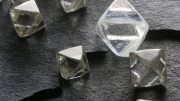In the first quarter of 2017, a market-cap weighted aggregation of diamond miners in U.S. dollars including Alrosa (RTS: ALRS), Petra Diamonds (LSE: PDL), Dominion Diamond (TSX: DDC; NYSE: DDC), Gem Diamonds (LSE: GEMD), Lucara Diamond (TSX: LUC), Stornoway Diamond (TSX: SWY), Firestone Diamonds (LSE: FDI), and Mountain Province Diamonds (TSX: MPV, NASDAQ: MPVD) was up 1.8%, versus the S&P 500, which was up 5.8%.
However, the above figure was skewed by a 29% return in Dominion, as the Canadian pure-play diamond miner drew a takeover proposal at a 36% premium. Taking Dominion out of the above calculation, the basket of diamond miners was down 0.7% in the quarter.
The period from Feb. 15 to March 13 was especially difficult for the diamond miners as the basket was down 14.3%., while the S&P 500 was up 1.1%, making an all-time high on March 1. During that period, $1.8 billion of market cap was erased from the largest pure-play diamond miner in the world as Alrosa’s stock declined 14.1%; Dominion shares were down 10 consecutive days (prior to the acquisition proposal), and both Stornoway and Mountain Province made 52-week lows.
The recovery of diamond prices following an industry-wide indigestion in 2015, a resilient post-election U.S. economy and stock market, and a more stable Chinese economy are all fundamentals supportive of diamond miners, but the stocks still displayed relative weakness in the first quarter.
Even the acquisition proposal (a formal bid was not made) in mid-March for Dominion, did not buoy the space. After an initial rally on the Dominion headline, Alrosa, Mountain Province, Gem Diamonds, and Stornoway all retreated back to mid-March lows.
Here are some thoughts as to why.
India’s demonetization
While the market expected India’s demonetization to have a negative impact on global diamond prices, recently released official sales results from Dominion, Stornoway, and Mountain Province have all highlighted the severity of the impact on smaller, lower-quality stones.
In February, Dominion reported that in the three months ending Jan. 31, diamonds from its primary mine, Ekati, only sold for US$77 per carat, down from US$175 per carat in the same period a year ago. In the recent quarter, 90% of Ekati’s diamonds came from the Misery Main pipe, which is rich in diamond quantity but poor in diamond quality. A year ago, more carat volume came from Ekati’s Koala pipe, which produces diamonds that are typically worth three to four times that of Misery Main. That said, Misery Main diamonds probably would have sold for closer to US$100 per carat without the
effect of the demonetization.
In Stornoway Diamond’s first ever sale, which was held in November, the company achieved an average price of US$185 per carat. However, the company noted that the price was skewed higher because lower-quality diamonds were withheld from sale due to a lack of demand. In February, the company released 2017 diamond price guidance of US$100-US$132 per carat (inclusive of lower quality stones), which is US$30-US$60 per carat below the mine plan diamond price. Stornoway did note diamond breakage in initial processing, which further increased the distribution of smaller diamonds produced by the company.
Mountain Province held its first diamond sale from Jan. 16-25, realizing an average price of US$127 per carat, although the company was only able to sell 75% of its offering, as lower-quality, notably brown colored stones, did not sell. The demonetization impacted the company’s average price achieved by an estimated 20-30%.
In March, Mountain Province reported that it sold all diamonds that were offered at its second sale, which was held in February, including those that did not sell in the first tender. The company did not disclose the average selling price achieved at its second sale, but in April provided full-year 2017 average price-per-carat guidance of US$70-US$90 per carat, which was well below most expectations.
Lucara’s bearish view of the diamond market
On Feb 16, in reporting its full-year results, Lucara Diamond struck a bearish note in its commentary, remarking that supply and demand fundamentals in the market remained unbalanced, resulting in a very cautious market. “The large volume of rough diamonds sold into the market in 2016 has not translated into increased sales of polished diamonds. Polished diamond price indices remain at very low levels, restricting the ability for rough diamond prices to see short term and sustainable growth.”
The company also noted that demonetization in India towards the end of 2016 resulted in low to almost no liquidity for polishers, and although this is a short-term concern, new supply coming onstream by three new producers may continue to affect prices for smaller and lower-quality rough stones.
After recovering the second largest rough diamond in history in 2015, the Lesedi La Rona, subsequent publicity has made Lucara one of the most well followed and recognizable diamond miners in the world. Since then, Lucara’s comments have impacted industry sentiment more than larger companies like ALROSA and Petra, which have both recently released more bullish views on the current state of the diamond market.
Rising interest rates
With the U.S. Federal Reserve raising interest rates on March 15, with subsequent additional hikes expected in 2017, there has been some rotation out of higher-yielding stocks into fixed income.
With Dominion, Lucara, and Alrosa yielding 4.3%, 3.6%, and 2.4%, respectively, which compares to the S&P 500 yielding 2.2%, these diamond miners are relatively high-yielding stocks, and are sensitive to asset class rotation tied to interest rates.
In addition, more hawkish monetary policy rhetoric has strengthened the U.S. dollar, which has also put pressure on the diamond miners, most of which are traded in non-U.S. dollars.
A general rotation out of commodity investments
Iron ore, gold and oil have been driven lower by weaker sentiment of late. After surging an 80% in 2016, iron ore is expected to be weaker in 2017 as a higher price, which was driven by government stimulated Chinese steel production, has led to global production capacity expansion. In February, the largest diversified miner in the world, BHP Billiton (NYSE: BHP LSE: BLT)), expressed caution, saying: “The (iron ore) market is likely to come under pressure in the short-term from moderating Chinese steel demand growth, high port inventories and incremental low-cost supply.”
In mid-March, gold dipped as the pending Fed rate raise depressed demand for gold as an inflation hedge. The gold price has since rallied, but remains volatile as the desire to own the safe haven fluctuates with every action taken by the new Trump administration and as the Euro-sensitive French election unfolds.
WTI crude oil has sold off over 11% since the beginning of the year as the rally in December, driven by an OPEC supply curtailment announcement, has given way to concern over increased U.S. shale oil production.
Large investors tend to move money in and out of asset classes and sectors as a whole, so a general flowing of money out of commodities and related stocks has sympathetically impacted the diamond miners.
Negative sentiment towards diamonds driven by coverage in The Economist
Widely read global financial publication The Economist recently published an article on how the “velben good” nature of diamonds is eroding. The article points to De Beers no longer controlling supply, the technological advancement of synthetic diamond production, and Millennials’ lackluster desire for material possessions, as threatening the value of diamonds.
While all of these topics are far from new to those in the industry, the widely distributed article put a negative spin on the longer-term prospects of the diamond industry.
Paul Zimnisky is an independent diamond industry analyst and can be contacted at www.paulzimnisky.com and followed on Twitter @paulzimnisky. At the time of writing, he held a long position in Dominion Diamond.
This story originally appeared in the June 2017 issue of Diamonds in Canada.




Be the first to comment on "Five reasons diamond stocks have been dragging"